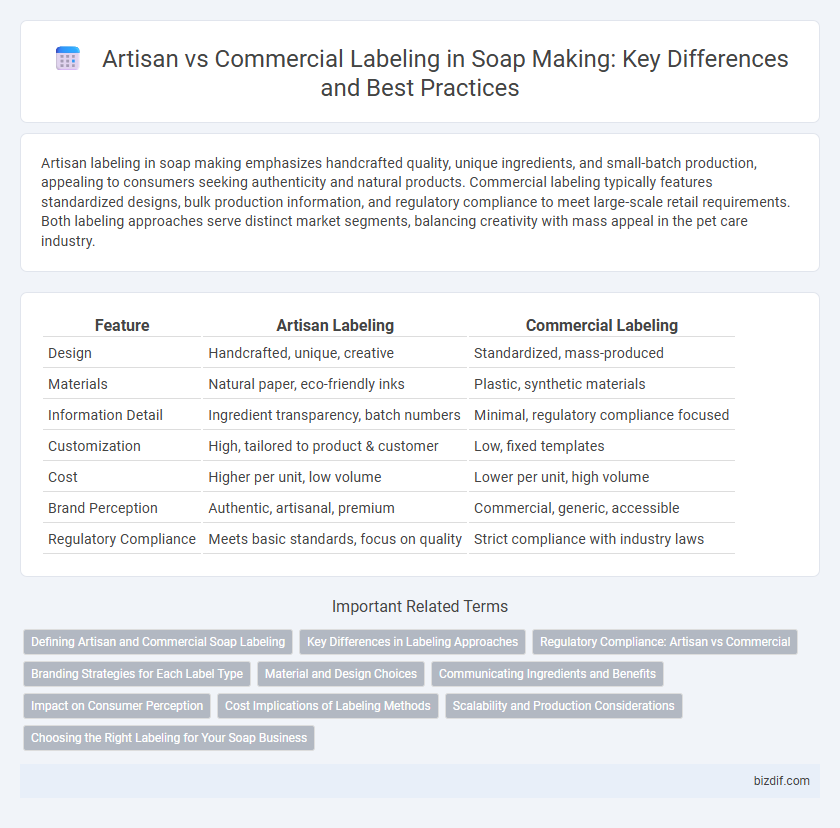Artisan labeling in soap making emphasizes handcrafted quality, unique ingredients, and small-batch production, appealing to consumers seeking authenticity and natural products. Commercial labeling typically features standardized designs, bulk production information, and regulatory compliance to meet large-scale retail requirements. Both labeling approaches serve distinct market segments, balancing creativity with mass appeal in the pet care industry.
Table of Comparison
| Feature | Artisan Labeling | Commercial Labeling |
|---|---|---|
| Design | Handcrafted, unique, creative | Standardized, mass-produced |
| Materials | Natural paper, eco-friendly inks | Plastic, synthetic materials |
| Information Detail | Ingredient transparency, batch numbers | Minimal, regulatory compliance focused |
| Customization | High, tailored to product & customer | Low, fixed templates |
| Cost | Higher per unit, low volume | Lower per unit, high volume |
| Brand Perception | Authentic, artisanal, premium | Commercial, generic, accessible |
| Regulatory Compliance | Meets basic standards, focus on quality | Strict compliance with industry laws |
Defining Artisan and Commercial Soap Labeling
Artisan soap labeling emphasizes handcrafted, small-batch production with natural ingredients and unique formulations, often highlighting the maker's personal touch and traditional techniques. Commercial soap labeling typically reflects mass production, standardized ingredients, and regulatory compliance, focusing on brand consistency and clear ingredient disclosure for broad market appeal. Understanding these distinctions helps consumers identify product quality, ingredient transparency, and the soap's origin.
Key Differences in Labeling Approaches
Artisan labeling emphasizes handcrafted qualities, unique ingredient sourcing, and small-batch production details to appeal to niche markets seeking authenticity. Commercial labeling prioritizes regulatory compliance, standardized information, ingredient lists, and barcodes for mass distribution and retail environments. The distinction lies in artisan labels highlighting storytelling and craftsmanship, whereas commercial labels focus on consistency and legal requirements.
Regulatory Compliance: Artisan vs Commercial
Artisan soap labeling must adhere to specific regulatory compliance standards including accurate ingredient lists, allergen disclosures, and proper usage instructions to ensure consumer safety and transparency. Commercial soap labeling often requires more stringent adherence to federal regulations such as the FDA's guidelines, including detailed claims substantiation, barcoding, and registration with regulatory bodies. Both artisan and commercial producers must stay current with labeling laws to avoid legal penalties and maintain market credibility.
Branding Strategies for Each Label Type
Artisan labeling in soap making emphasizes handcrafted quality, unique designs, and personalized branding that appeals to niche markets seeking authenticity and natural ingredients. Commercial labeling concentrates on standardized packaging, clear regulatory compliance, and consistent brand messaging to attract mass-market consumers and ensure broad retail distribution. Effective branding strategies leverage storytelling and visual identity in artisan labels while prioritizing trustworthiness and recognizability in commercial labels.
Material and Design Choices
Artisan soap labeling involves handcrafted materials such as recycled paper, kraft paper, or textured cardstock, emphasizing eco-friendly and rustic aesthetics that highlight the natural origins of ingredients. Commercial labeling often uses synthetic materials like glossy or plastic-coated paper designed for mass production, durability, and vibrant, consistent color prints that appeal to broad retail markets. Design choices for artisan labels focus on minimalistic, organic fonts and hand-drawn illustrations to convey authenticity, while commercial labels prioritize bold graphics and brand logos for high shelf impact and brand recognition.
Communicating Ingredients and Benefits
Artisan labeling in soap making emphasizes transparent, detailed ingredient lists and highlights unique, natural components such as essential oils, organic botanicals, and cold-pressed oils to communicate product benefits effectively. Commercial labeling often presents simplified ingredient information with standardized benefits claims, catering to mass-market recognition and regulatory compliance. Clear, ethical ingredient disclosure on artisan labels fosters consumer trust and educates buyers about the soap's nourishing, skin-friendly properties.
Impact on Consumer Perception
Artisan labeling in soap making emphasizes handcrafted quality, unique ingredients, and small-batch production, which enhances consumer perception of authenticity and exclusivity. Commercial labeling often highlights standardized branding, mass production, and cost-effectiveness, appealing to consumers prioritizing consistency and affordability. The distinction in labeling significantly influences consumer trust, perceived value, and purchasing decisions within the soap market.
Cost Implications of Labeling Methods
Artisan labeling in soap making typically involves hand-applied, smaller batch labels that increase production time and material expenses, leading to higher per-unit costs. Commercial labeling uses automated equipment and bulk-printed labels, significantly reducing labor and material costs per soap bar. Choosing artisan labels enhances product uniqueness but elevates overall labeling expenses compared to the cost-efficiency of commercial labeling methods.
Scalability and Production Considerations
Artisan labeling in soap making emphasizes handcrafted appeal and uniqueness, suited for small-scale production with limited batch sizes and customizable designs. Commercial labeling focuses on scalability, utilizing automated processes and standardized packaging to meet high-volume demands efficiently. Production considerations include regulatory compliance, cost per unit, and shelf stability, which are critical for commercial labels but more flexible for artisanal products.
Choosing the Right Labeling for Your Soap Business
Selecting the right labeling for your soap business depends on brand identity and target audience preferences. Artisan labeling emphasizes handcrafted quality and unique designs, appealing to niche markets seeking authenticity and exclusivity. Commercial labeling focuses on mass production efficiency and compliance with industry standards, ideal for businesses aiming for broad market reach and consistent branding.
Artisan Labeling vs Commercial Labeling Infographic

 bizdif.com
bizdif.com